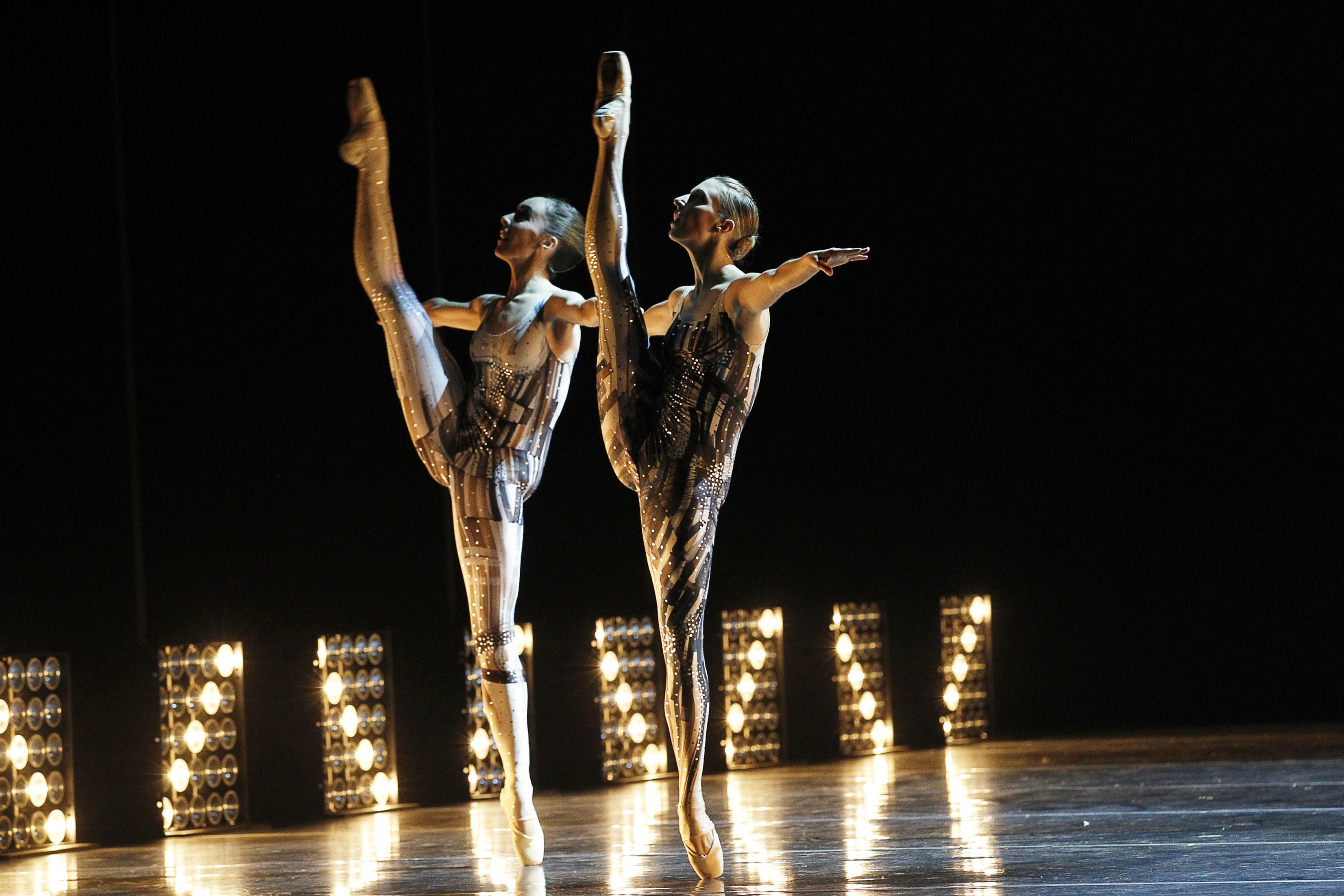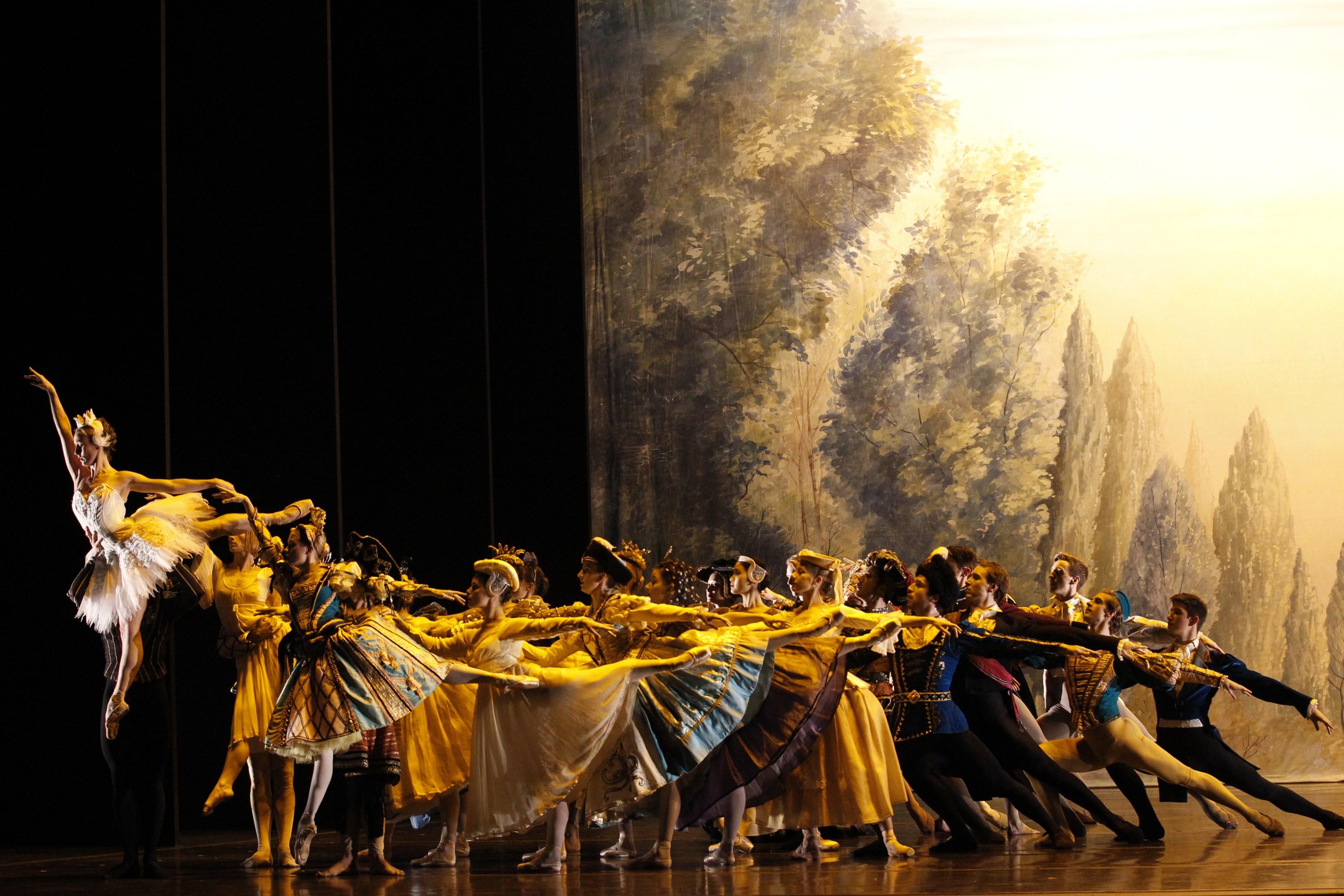This is an expanded version of a review written for The Canberra Times.
24 February 2012, State Theatre, Victorian Arts Centre, Melbourne
Infinity, the Australian Ballet’s first program in its 50th anniversary year, is a diverse and sometimes challenging evening of dance. But most of all it is thrilling experience to see the Australian Ballet putting itself out on a limb with three brand new works from three Australian choreographers: Graeme Murphy, Gideon Obarzanek and Stephen Page. All three works are danced to new scores by Australian composers and all three have new Australian designs. Definitely something to celebrate.
The show opens with the new work from Murphy, The narrative of nothing. To tell the truth, while there is a perfectly good explanation from Murphy for why this title was chosen—there’s no obvious narrative but the work may still be telling the audience something, I’d much rather dispense with titles that sound smart (with all due respects to Murphy). Untitled works just as well for me!
Murphy’s choreography often had a primeval feel as bodies twisted and curled around others. There were powerful performances from Lana Jones and Adam Bull, and I especially admired the sequence where Jones was partnered by several men who alternated between holding her aloft and letting her fall from side to side. Vintage Murphy really but Jones’ ability to hold her body in a perfect curve as she fell was breathtaking.

The supporting dancers deserve praise for their technical strength as they attacked the demanding choreography. Murphy has moved a step beyond his usual (always interesting) vocabulary and made a work that, in somewhat of a contradiction, asks the dancers to move with a kind of aggressive lyricism.
I didn’t read the program notes prior to watching this work so wasn’t aware in advance that the commissioned score, Fire Music by Brett Dean, was in response to the Victorian ‘Black Saturday’ bushfires of 2009. With the knowledge of what was behind Dean’s score, fire in some respects becomes the non-narrative. But the works stands without this knowledge and in fact I was pleased that I didn’t know in advance. The score sounded quite elemental—the thunder sheets certainly helped there—and, with some instruments positioned outside the pit, the sound was enveloping.
Jennifer Irwin’s body hugging costumes were decorated individually with black patterns, often swirling organically, and with what looked like silver studs or tiny mirrors. Depending on the lighting (by Damien Cooper) they changed from looking a little punk, to glowing in the dark, to looking slinky, and much more. Cooper’s design was uncompromising—a solo by Adam Bull performed pretty much on the spot in a strong downlight was another highlight. The design also included an onstage use of lighting rigs not normally on view to the audience, another technique that has often featured in works by Murphy. With the inclusion of a minimalist black space as a setting The narrative of nothing became an example of the very best of contemporary collaborative enterprises. It also looks back to some of Murphy’s strongest abstract works made for Sydney Dance Company—Piano sonata comes straight to mind.
Obarzanek’s piece also had a strange, or at least not very catchy title, There’s definitely a prince involved. It referred to his process of generating ideas and vocabulary for the work by asking a range of people about what they thought constitutes a ballet, and his subsequent deconstruction of the ballet Swan Lake. The work can be read on a number of levels. On the most simplistic it tells the story of Swan Lake, using the dancers as narrators, and focuses on the illogicality of the story. It relies on the dancers’ deadpan delivery of the text to raise laughter from the audience, and the various dancers who take on the role of narrator throughout the piece are more than adept. Unfortunately, even though they used a microphone, their voices were often inaudible above the crashing sounds of the orchestra playing Stefan Gregory’s fragmentation of Tchaikovsky’s familiar Swan Lake music.
On another level the work rips apart the traditional choreography of Swan Lake, and amusingly so, especially in the section based on the dance of the four little swans. It helps but is not essential if the audience is familiar with the traditional steps.
On yet another level the work can be seen as a comment on art asking the question of whether Swan Lake is indeed a work of art. Obarzanek has an acutely inquiring mind and his ability to force us to reconsider what we as a ballet audience might take for granted is powerful and actually quite respectful.
There’s definitely a prince involved uses dancers of the Australian Ballet augmented by dancers from Obarzanek’s company, Chunky Move. Australian Ballet principal Madeleine Eastoe showed her versatility as a performer and slotted beautifully into the varying demands associated with the role of a deconstructed Odette, the female lead. The few moments of classical movement—a fabulous grand jeté across the stage, and her ‘dying swan’ poses—did however make me yearn to see her dance a ‘real’ Swan Lake. Deconstruction is fine, entertaining and thought provoking, but the classic version transcends it all and it is that strength really that allows Obarzanek’s deconstruction to work so well.

The program closes with Page’s Warumuk—in the dark light with Bangarra Dance Theatre joining forces with the Australian Ballet. With its new score from David Page it presents an exploration of the myths associated with the night sky.
The Bangarra dancers performed with their usual, beautifully rehearsed ensemble work with particularly striking performances from Elma Kris and Waangenga Blanco representing Full Moon. Vivienne Wong, stunningly dressed by Jennifer Irwin in a lacy black outfit cut with a long ‘tail’ at the back, stood out as the Evening Star. For me Wong was the sole Australian Ballet dancer who was able to transcend her balletic training and blend into the Bangarra way of moving. This was a real feat as Bangarra has now consolidated its own very distinctive style and company dancers are performing with added assurance and expertise.
The one disappointment for me was Jacob Nash’s set design. To me it looked a little too much like a previous Bangarra commission, his set designs for ‘About’, part of the Belong program of 2011.
This program is the Australian Ballet in an extreme mood. I have nothing but praise for the courage of the company in taking on, and succeeding in a program that far surpasses anything they have done in recent years. It makes the company look at last as though it is a company with a desire to move ballet into the future.
Michelle Potter, 27 February 2012
Postscript: The Canberra Times review appeared on 17 March 2012. It is no longer available online.
Unlike Michelle, I had read reports that Dean’s score was a co-commission and took the Black Saturday bushfires as a starting point. I had also read Murphy’s statements regarding the meanings audiences take from so called abstract dance works. While my response may have something to do with the foreknowledge about the score, perhaps Graeme is playing possum a bit about what he has built into this work. I found that the alternately terrifying and nervously calm, all enveloping sound world that the score produces in the theatre allied with the black stage surround and unsettling lighting effects, suggested something quite elemental akin to Rite Of Spring. The dancers seemed to be partaking in a grim ritual perhaps in appeasement of a fire god symbolised by the globe of light which starts the ballet and ends it. There were many suggestions of animal movements [even Faune type poses]. I had fleeting visions of the dancers as ash columns given the superb body tight designs of Jennifer Irwin and the aerial movements which flickered every which way. On a construction level there were many superbly varied sections of male and female duos [the Hannaford/Thompson duo was remarkably suggestive], trios, soloist with groups and some astoundingly beautiful chain groupings. I found this work a quite staggering achievement on every level with multiple layers of ideas and references and possible poetic meanings.
However that’s where the programme ended for me. While Page’s work was fine in the Bangarra style [and it was good to hear a live orchestral accompaniment] the Obarzanek work was puerile. Surely we all are sophisticated enough to be able to carry more than one idea in our head as regards Swan Lake. And doesn’t ballet operate on the level of poetic suggestion rather than literal meaning? Doesn’t the disappearance of Nikiya at the end of the Shades scene in Bayadere, for instance, instill in the audience at the deepest level an overwhelming sense of loss whether an actual loss one has sufered or the identification with such a loss? We are not really concentrating on the details of the creaky orientalist plot. And what is it with having dancers speak? Isn’t their language steps and body movement? Given the wholesale accomodation of the traditional Lac choreography and the utterly pathetic new work for the Australian Ballet corps, I would suggest Obarzanek was at a complete loss as to how to use the classical dancers and brought in the guests to perform in his own style. And what an insult to the designer Tom Lingwood to have his Swan Lake costumes used in such a way. Jumbled together without any thought as to their original colour groupings, a silly shawl added to the Black Swan costume, and all mixed with other costumes from productions I couldn’t identify [apart from the awful new fringed get-ups]. I know the artistic direction is producing a new Swan Lake this year [to be designed by Hugh Colman whose name appears as a credit on this ballet for the use of his backdrops -there is no credit given to Tom Lingwood] but that is no reason to dance on the grave of a production that served the dancers and audiences very well for many years.
I think I will look at the work quite differently when I see it next in Sydney. However, I am still glad I didn’t read anything in advance. I think the work does stand without any background knowledge of the score, or of Murphy’s current pronouncements on abstraction. I didn’t read any narrative elements into the globe of light at the beginning (and end) either. Murphy’s lighting designers (in conjunction with Murphy no doubt) do things like that often. I agree about the possible references to Faune. I also kept seeing a version of that triple arabesque pose from Apollo and other bits that reminded me of Balanchine, which softened the hard-edged character of much of the choreography. But it is a fabulous piece of collaboration whatever way we look at it.
I’ve had my say about the rest of the program, although I quite liked the fringed shawl that Odile got to wear! I take Adrian’s point though about Lingwood, or at least the meddling with his costumes: probably not the most respectful act. But given the aesthetic behind Obarzanek’s work it didn’t seem jarring.
The one thing I didn’t say in either The Canberra Times review or my post is that in many respects the whole program is a tribute to Graeme Murphy. No only is his own new work astonishing in its achievement in every area and as a collaborative whole, and Adrian is absolutely right about the multiple layers, Murphy nurtured both Obarzanek and Page in the early days of Sydney Dance Company, both as performers and emerging choreographers.